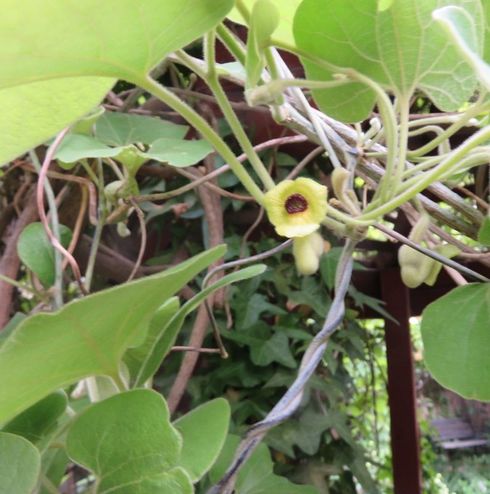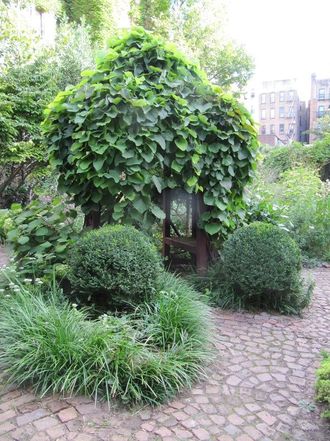Dutchman's Pipe (Aristolochia macrophylla)
|
Dutchman's Pipe (Aristolochia macrophylla)
Common Name: Pipevine Genus: Aristolochia Family: Aristolochiaceae (birthwort) Species: Aristolochia macrophylla Type: Perennial Hardiness: Zones 4 - 8 Bloom Time: blooms May - June Exposure: Full sun to partial shade Height: Can reach a height of 20 - 30 feet. Spread: Wide Description: Dutchman's Pipe is a woody, deciduous, climbing, flowering vine. The flowers are numerous but small and often hidden under the leaves. The flower is shaped like a meerschaum pipe, giving the vine its common name. The leaves are cordate (i.e. heart-shaped) and large, ranging between 6–12 inches . In the early stages of its development, the vines are very stiff and rigid, but as the plant develops, the vines become much more flexible and stable. Seeds ripen in September and October, Spreads rapidly. Cultivation: Plant in humus-rich soil with good drainage. Keep the ground evenly moist during the growing season. Plant where it will have plenty of room to grow. Spreads rapidly, can crowd out smaller plants.. Dutchman's pipe is a twining climber, so needs sturdy support such as a fence or gazebo. Prune in late winter or early spring. Prune off no more than one-third of a plant's growth in the course of the entire year. Look for the weakest branches and any growth that seems to be getting out of hand. Fertilizer: Lightly fertilize in spring Soil and pH: Humus rich soil with good drainage Watering: Keep ground evenly moist Pests/Diseases: None Species Support: Important host plants for butterflies. According to the North American Butterfly Association (NABA), "Pipevine is the primary food for Pipevine Swallowtail." Pipevine plants contain chemicals that when ingested by the caterpillars make them poisonous." As a result, would-be predators avoid eating the caterpillars. Propogation: From seeds or stem cuttings. Harvest seedpods after they have dried on the vine. Sow them indoors in seed flats and transplant outdoors after the soil has warmed to at least 60 F. Take cuttings in spring when terminal growth is new and root in a glass of water. Plant once root system has developed. Water well until new plants are established. Notes/Gardening Tips: Dutchman's pipe vines are often trained to grow up the front of a porch providing shade during summer heat, as well as privacy. The density of its foliage also makes Dutchman's pipe vine effective in hiding eyesores such as chain link fencing. Dutchman's pipe is native to the eastern United States. Aristolochia tomentosa belongs to the Aristolochiaceae family of plants and is found from Maine to Alabama, reaching all the way to Georgia, Tennessee and Kansas, and up to Michigan, with the exception of Ohio, Indiana and Illinois, and reaches the southeast up until Florida where the presence of this species comes to an abrupt halt. It is also common in Mississippi and Alabama all the way up north to Maine and Ontario, Canada. Sources: Wikipedia, "The Spruce", USDA |


